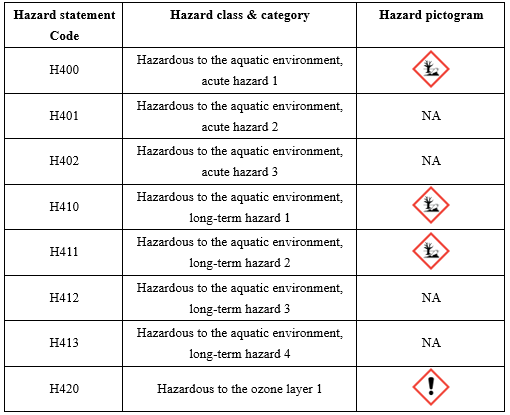GHS hazard pictograms
GHS hazard pictograms means a graphical composition that may include a symbol plus other graphic elements, such as a border, background pattern or colour that is intended to convey specific information.
GHS pictograms for sectors other than transport are assigned a unique alphanumerical code (a total of 9 from GHS01 to GHS09). The pictogram code is intended to be used for references purposes. It is not part of the pictogram and should not appear on labels or in section 2 of the safety data sheet (SDS). The following table lists the correspondence among GHS pictograms, codes, and symbols:

Among the above symbols, with the exception of the new symbol which will be used for certain health hazards and the exclamation mark, the remaining 7 symbols are part of the standard symbol set used in the UN Model Regulations. In addition to these 7 symbols, the UN Model Regulations also include transport pictograms that are not under GHS pictograms. Pictograms prescribed by the GHS but not the UN Model Regulations, should have a black symbol on a white background with a red frame sufficiently wide to be clearly visible. However, when such a pictogram appears on a label for a package which will not be exported, the competent authority may choose to give suppliers and employers discretion to use a black border. For example, the latest official GB 30000.1-2024 in China provides relevant exemptions: "For domestic use, the border can be black.”
Related Links
China Officially Updates GHS General Rules (GB 30000.1-2024) in Line with GHS 8
It should be noted that, where a UN Model Regulations pictogram appears on a label, a GHS pictogram for the same hazard should not appear. The GHS pictograms not required for the transport of dangerous goods should not be displayed on freight containers, road vehicles or railway wagons/tanks. For more details of the transport pictograms in the UN Model Regulations, please follow our Chemradar https://www.chemradar.com/
Understanding the correspondence between GHS hazard pictograms and hazard statements is equally important as they are components of the label elements. The following table lists the correspondence between H codes and GHS pictograms:
Physical hazards

Health hazards

Environmental hazards

The hazard categories listed in the above table are under the latest 10th revised edition of the UN GHS. To specifically comply with the GHS regulations of a certain country, it is necessary to correspond according to the requirements of their national regulations.
About GHS
GHS (Globally Harmonized System of Classification and Labeling of Chemicals) is a technical guidance published in 2003 by the United Nations (UN), also referred to as the UN GHS/purple book, which is used to address the classification of chemicals by types of hazard and harmonized hazard communication elements, including labels and safety data sheets. Now the lastest version is the 10th rev. UN GHS. It aims at providing a basis for harmonization of rules and regulations on chemicals at national, regional and worldwide level.
If you need any assistance or have any questions, please get in touch with us via service@hfoushi.com.
Further Information
Singapore to Implement UN GHS Rev.7
Japan Updates GHS Classifications for 160 Chemicals
U.S. OSHA Amends Hazard Communication Standard to Align with GHS Rev. 7
China Taiwan OSHA Revising GHS Classification Standards and Introducing 8th Revision of GHS

